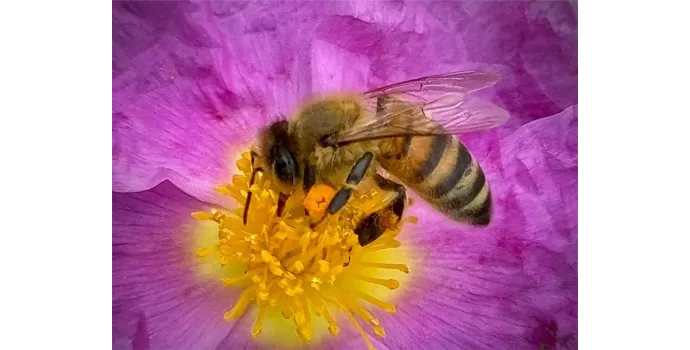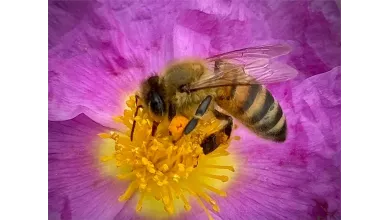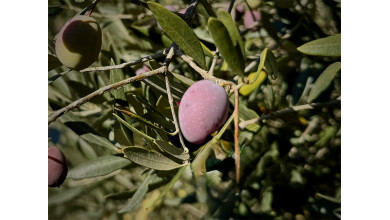Apis's Journey, Guardian of the Hive

The Fascinating Life of a Honeybee
Behind every spoonful of honey lies the meticulous work of hundreds of bees, driven by an extraordinary sense of duty and remarkable collective coordination within the hive. Each bee has its place and lives according to a well-defined hierarchy, where every individual has a specific role. Let us follow the journey of our little bee, "Apis", from her birth, through her missions within the colony, to her final flight.
The Birth of Apis
-
"Réina-Zephir" queen of the hive, and the only fertile female, is fed exclusively on royal jelly. On this beautiful spring day, it is time for her to lay eggs. She delicately deposits a drop of life into each wax cell, carefully prepared by the worker bees to receive her precious offspring. Among them is the egg that will become "Apis". For three days, it rests there, cradled by the soft vibrations of the nurse bees, until it hatches into a tiny white larva.
-
Young nurse bees take turns day and night feeding the larvae - first with royal jelly, then with "bee bread" (a mixture of honey and pollen). Apis and her sisters grow rapidly. In just a few days, they are ready to transform. The nurse bees then seal the cells with wax. In the darkness of her cocoon, Apis transform into a pupa. Gradually, her eyes, wings, fuzzy legs, and beautifully striped body form. On the 21st day, she chews through the wax cap and emerges from her cocoon. Apis is now a young, energetic bee, ready to begin her life. She will live for about 40 days, each one intense and precious.
Apis' Active Life
-
Her first mission comes quickly : cleaning her cradle. Using her mandibles, she scrapes away bits of wax, dust, cocoon remains, and microscopic waste from the cell she just left. With her front legs equipped with comb-like brushes, she polishes the walls. Her sensitive antennae ensure nothing smells or sticks. She even licks the walls with her tongue to remove traces of fermented honey or pollen. Her saliva contains antibacterial enzymes that naturally disinfect the cell. Once her work is done, she inspects the cells of other young bees - and they inspect hers to ensure all cradles are perfectly clean for Queen Réïna-Zephir's future eggs.
-
On the fourth day, Apis becomes a nurse bee for seven days. Feeding young larvae is a delicate task that she performs with care. She visits each larva, up to 1,300 times a day - feeding the youngest with royal jelly and the older ones with a mix of honey and pollen. She adapts the quantity and the type of food to each larva's age. Her sleep is fragmented into micro-naps, totaling only 1-2 hours per day.
-
From the eleventh day, Apis becomes a wax builder. She produces wax from glands beneath her abdomen and kneads it with her mandibles into perfect hexagonal walls. She builds identical cells with precise angles and inclinations to prevent honey from spilling.
Apis also stores nectar from brought by forager bees. These foragers pass the nectar to her through trophallaxis : they regurgitate it, and Apis, now a receiver bee, takes it with her tongue. She keeps it in her mouth for a few minutes, chews it, and then regurgitates it again. This process can repeat several times with enzymes like invertase added each time to aid preservation.
Once enriched, the nectar is spread in thin layers on the hive's walls. Since nectar contains 70-80% water, it must be evaporated. To do this, Apis and the other bees beat their wings to ventilate the hive. The nectar must reach less than 18% moisture to become honey. Apis transfers it between several shallow cells to enhance drying. The workers then test its consistency using their antennae and tongues to check if it's thick enough.
When fully concentrated, the nectar becomes mature honey. Apis transfers it to a clean, deep cell for longterm storage. Other workers help fill the cell to the brim. Once full, Apis and her sisters seal it with a thin wax cap. This wax, produced from sugar consumed by the bees, forms in flakes under their abdomens. They soften and shape the flakes with their mandibles to create a perfect seal, protecting the honey from air and moisture. Durind this stage of her life, Apis can rest 2 to 3 hours each night in an empty cell. She communicates regularly with her sisters by touching antennae to exchange vital information for the smooth running of the hive.
-
From the seventeenth to the twentieth day, Apis discovers the world outside, hovering at the hive entrance. She becomes a guard bee, sniffing every bee entering or exiting the hive. She controls traffic to avoid. Guarding in shifts of 5 to 30 bees, she stays alert, ready to repel intruders like wasps or hornets. Between patrols, she takes short rests and sleeps lightly. Guard duty is risky, as a sting could cost her life. Her barbed stinger, once embedded in the elastic skin of a mammal, tears from her body if she tries to withdraw. However, against other insects with tough shells, the sting doesn't stick.
-
From her twenty-first day 21, Apis becomes a forager bee. She venture into the real world, discovering endless fields and fragrant flowers. She performs orientation flights, memorizing landscapes, ground patterns and the sun's position. She flies up to 3 km per day in search of nectar, pollen, water, and propolis. When she finds an abundant food source, she performs a waggle dance - a figure-eight movement that communicates the direction (relative to the sun) and distance (via dance speed) to her sisters.
With her slender tongue up to 6 mm long, she sips nectar from deep within flowers, stores it in her crop (which can carry up to 70 mg - nearly her own weight), and brings it back to the hive to pass too a receiver bee. She collects pollen with her hind legs, compressing it into pellets in her pollen baskets. She fetches water to dilute honey, cool the hive, and feed the brood. She scrapes poplar and pine buds to gather propolis (resin), used as a natural glue and disinfectant. Apis can visit up to 800 flowers per day. She is rewarded with restful nights, sleeping 6 to 8 hours deeply and peacefully, either on the edge of the hive or hanging from a wall with her loyal forager companions.
Apis' Final Dance
After about twenty days, her wings become frayed. She is no longer strong. Our brave little bee is exhausted. To avoid disrupting the hive, she discreetly leaves it behind to die alone, peacefully, in a quiet corner of nature she chooses for herself. Had she been born at the end of summer, she might have lived 4 to 6 months, with less work to do. But our sweet Apis leaves behind a well-functioning hive. She has contributed to the well-being of the flora and fauna by pollinating flowers. Her life story is short but intense. Without her, there would be no flowers, no fruit, and no honey. Each bee is a precious guardian of nature - let us protect her.
Creamy Lavender Honey 250g
Designation : PGI Lavender Honey Produced and Harvested in...
- Online only
Creamy Lavender Honey 500g
Designation : PGI Lavender Honey Produced and Harvested in...
- Online only









































Leave a comment